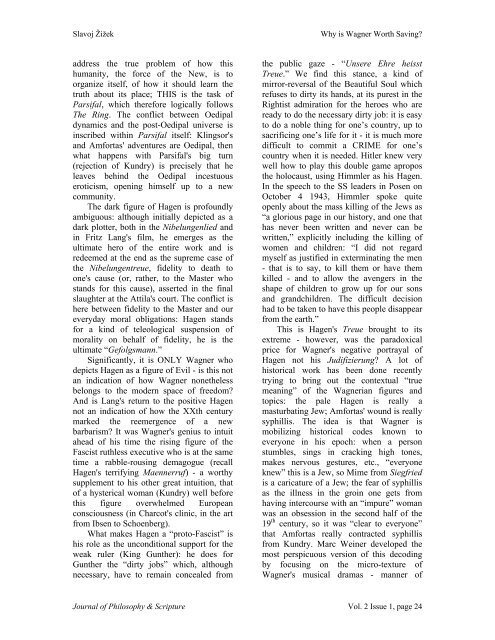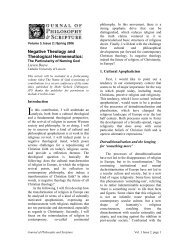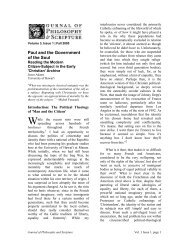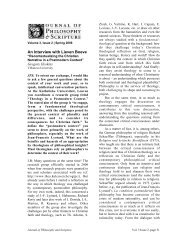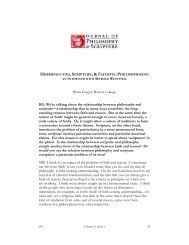Why is Wagner Worth Saving? Slavoj Žižek - Journal of Philosophy ...
Why is Wagner Worth Saving? Slavoj Žižek - Journal of Philosophy ...
Why is Wagner Worth Saving? Slavoj Žižek - Journal of Philosophy ...
You also want an ePaper? Increase the reach of your titles
YUMPU automatically turns print PDFs into web optimized ePapers that Google loves.
<strong>Slavoj</strong> Žižek<br />
<strong>Why</strong> <strong>is</strong> <strong>Wagner</strong> <strong>Worth</strong> <strong>Saving</strong>?<br />
address the true problem <strong>of</strong> how th<strong>is</strong><br />
humanity, the force <strong>of</strong> the New, <strong>is</strong> to<br />
organize itself, <strong>of</strong> how it should learn the<br />
truth about its place; THIS <strong>is</strong> the task <strong>of</strong><br />
Parsifal, which therefore logically follows<br />
The Ring. The conflict between Oedipal<br />
dynamics and the post-Oedipal universe <strong>is</strong><br />
inscribed within Parsifal itself: Klingsor's<br />
and Amfortas' adventures are Oedipal, then<br />
what happens with Parsifal's big turn<br />
(rejection <strong>of</strong> Kundry) <strong>is</strong> prec<strong>is</strong>ely that he<br />
leaves behind the Oedipal incestuous<br />
erotic<strong>is</strong>m, opening himself up to a new<br />
community.<br />
The dark figure <strong>of</strong> Hagen <strong>is</strong> pr<strong>of</strong>oundly<br />
ambiguous: although initially depicted as a<br />
dark plotter, both in the Nibelungenlied and<br />
in Fritz Lang's film, he emerges as the<br />
ultimate hero <strong>of</strong> the entire work and <strong>is</strong><br />
redeemed at the end as the supreme case <strong>of</strong><br />
the Nibelungentreue, fidelity to death to<br />
one's cause (or, rather, to the Master who<br />
stands for th<strong>is</strong> cause), asserted in the final<br />
slaughter at the Attila's court. The conflict <strong>is</strong><br />
here between fidelity to the Master and our<br />
everyday moral obligations: Hagen stands<br />
for a kind <strong>of</strong> teleological suspension <strong>of</strong><br />
morality on behalf <strong>of</strong> fidelity, he <strong>is</strong> the<br />
ultimate “Gefolgsmann.”<br />
Significantly, it <strong>is</strong> ONLY <strong>Wagner</strong> who<br />
depicts Hagen as a figure <strong>of</strong> Evil - <strong>is</strong> th<strong>is</strong> not<br />
an indication <strong>of</strong> how <strong>Wagner</strong> nonetheless<br />
belongs to the modern space <strong>of</strong> freedom?<br />
And <strong>is</strong> Lang's return to the positive Hagen<br />
not an indication <strong>of</strong> how the XXth century<br />
marked the reemergence <strong>of</strong> a new<br />
barbar<strong>is</strong>m? It was <strong>Wagner</strong>'s genius to intuit<br />
ahead <strong>of</strong> h<strong>is</strong> time the r<strong>is</strong>ing figure <strong>of</strong> the<br />
Fasc<strong>is</strong>t ruthless executive who <strong>is</strong> at the same<br />
time a rabble-rousing demagogue (recall<br />
Hagen's terrifying Maennerruf) - a worthy<br />
supplement to h<strong>is</strong> other great intuition, that<br />
<strong>of</strong> a hysterical woman (Kundry) well before<br />
th<strong>is</strong> figure overwhelmed European<br />
consciousness (in Charcot's clinic, in the art<br />
from Ibsen to Schoenberg).<br />
What makes Hagen a “proto-Fasc<strong>is</strong>t” <strong>is</strong><br />
h<strong>is</strong> role as the unconditional support for the<br />
weak ruler (King Gunther): he does for<br />
Gunther the “dirty jobs” which, although<br />
necessary, have to remain concealed from<br />
the public gaze - “Unsere Ehre he<strong>is</strong>st<br />
Treue.” We find th<strong>is</strong> stance, a kind <strong>of</strong><br />
mirror-reversal <strong>of</strong> the Beautiful Soul which<br />
refuses to dirty its hands, at its purest in the<br />
Right<strong>is</strong>t admiration for the heroes who are<br />
ready to do the necessary dirty job: it <strong>is</strong> easy<br />
to do a noble thing for one’s country, up to<br />
sacrificing one’s life for it - it <strong>is</strong> much more<br />
difficult to commit a CRIME for one’s<br />
country when it <strong>is</strong> needed. Hitler knew very<br />
well how to play th<strong>is</strong> double game apropos<br />
the holocaust, using Himmler as h<strong>is</strong> Hagen.<br />
In the speech to the SS leaders in Posen on<br />
October 4 1943, Himmler spoke quite<br />
openly about the mass killing <strong>of</strong> the Jews as<br />
“a glorious page in our h<strong>is</strong>tory, and one that<br />
has never been written and never can be<br />
written,” explicitly including the killing <strong>of</strong><br />
women and children: “I did not regard<br />
myself as justified in exterminating the men<br />
- that <strong>is</strong> to say, to kill them or have them<br />
killed - and to allow the avengers in the<br />
shape <strong>of</strong> children to grow up for our sons<br />
and grandchildren. The difficult dec<strong>is</strong>ion<br />
had to be taken to have th<strong>is</strong> people d<strong>is</strong>appear<br />
from the earth.”<br />
Th<strong>is</strong> <strong>is</strong> Hagen's Treue brought to its<br />
extreme - however, was the paradoxical<br />
price for <strong>Wagner</strong>'s negative portrayal <strong>of</strong><br />
Hagen not h<strong>is</strong> Judifizierung? A lot <strong>of</strong><br />
h<strong>is</strong>torical work has been done recently<br />
trying to bring out the contextual “true<br />
meaning” <strong>of</strong> the <strong>Wagner</strong>ian figures and<br />
topics: the pale Hagen <strong>is</strong> really a<br />
masturbating Jew; Amfortas' wound <strong>is</strong> really<br />
syphill<strong>is</strong>. The idea <strong>is</strong> that <strong>Wagner</strong> <strong>is</strong><br />
mobilizing h<strong>is</strong>torical codes known to<br />
everyone in h<strong>is</strong> epoch: when a person<br />
stumbles, sings in cracking high tones,<br />
makes nervous gestures, etc., “everyone<br />
knew” th<strong>is</strong> <strong>is</strong> a Jew, so Mime from Siegfried<br />
<strong>is</strong> a caricature <strong>of</strong> a Jew; the fear <strong>of</strong> syphill<strong>is</strong><br />
as the illness in the groin one gets from<br />
having intercourse with an “impure” woman<br />
was an obsession in the second half <strong>of</strong> the<br />
19 th century, so it was “clear to everyone”<br />
that Amfortas really contracted syphill<strong>is</strong><br />
from Kundry. Marc Weiner developed the<br />
most perspicuous version <strong>of</strong> th<strong>is</strong> decoding<br />
by focusing on the micro-texture <strong>of</strong><br />
<strong>Wagner</strong>'s musical dramas - manner <strong>of</strong><br />
<strong>Journal</strong> <strong>of</strong> <strong>Philosophy</strong> & Scripture Vol. 2 Issue 1, page 24


